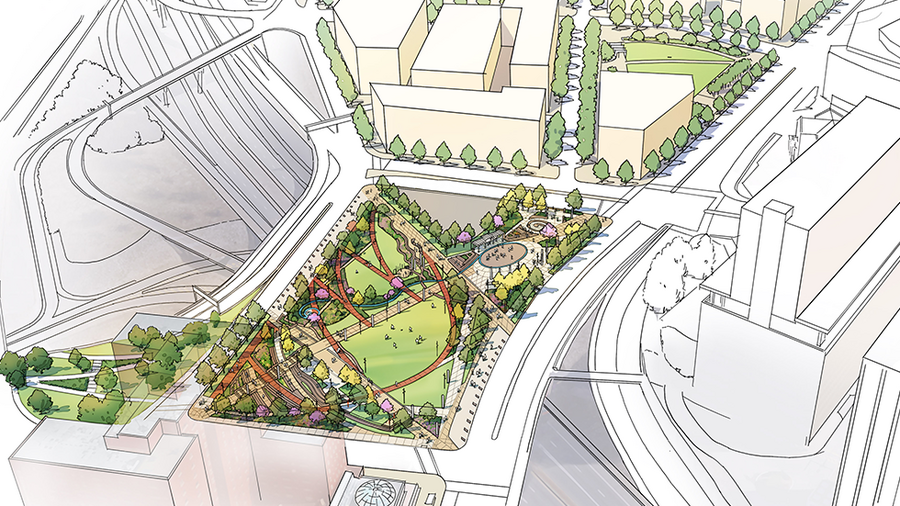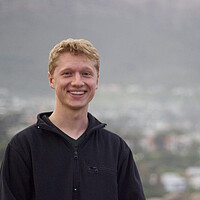'Deck parks' restore community ties in neighborhoods divided by highways
Loading...
When Marvin Anderson walks along the tree-lined streets of Rondo – his childhood neighborhood – in St. Paul, Minn., the memories come rushing back. “That’s what I miss about it ... the smells of the food, hearing laughter ... in the barbershop, over a soda fountain,” he says.
Mr. Anderson was born in this primarily African-American neighborhood in 1949. As a child, he thrived on Rondo’s culture of openness, in which black residents felt free from discrimination, says Anderson, now the executive director of ReConnectRondo – a nonprofit pushing for infrastructure that would revitalize the region.
But in 1956 the city approved the construction of Interstate 94 through the middle of Rondo. To build each stage, St. Paul bulldozed blocks of local businesses and homes – including several apartments Anderson’s father owned.
The neighborhood still feels the aftermath, says Anderson. “The destruction of Rondo has created ... a wandering group of people ... without a sense of home,” he says.
Along with the Minnesota Department of Transportation, Anderson and ReConnectRondo have been seeking to rebuild that sense of home by advocating for the Rondo Land Bridge. This grassy installation would extend over several blocks of I-94 and merge the divided north and south sides of the neighborhood with public green space and new homes.
Decades after developers pushed highways through US neighborhoods like Rondo in the name of progress, many are now reexamining how this development has contributed to urban inequality. (It’s also part of the discussion around new development. Early this year, the Monitor looked at the effect of infrastructure development on communities in Denver.) From St. Paul to Dallas to Pittsburgh, city halls are backing “deck parks” or “cap parks” – built above highways – that reinvigorate local urban life and pay homage to displaced communities.
“Some of the history around where highways were placed was clearly directly connected to structural and institutional racism,” says Lyneir Richardson, executive director of the Center for Urban Entrepreneurship and Economic Development at Rutgers University.
Deck parks are nothing new, but while some over the past decade were used to cap main arteries of urban wealth, more recent park plans are emerging in outer neighborhoods with more people of color.
“[G]iving a community where there’s a large population of people of color an opportunity to create a new vision ... it’s a huge opportunity to create wealth and ... increase health outcomes,” says Dr. Richardson, who visited Rondo as part of a consulting team from the Urban Land Institute.
Another planned deck park in Dallas’s Oak Cliff neighborhood seeks to rejuvenate this black and Latino community situated around Interstate 35.
“There was a 100 percent overlap between less-valued land and places where minority communities lived,” says Kathryn Holliday, associate professor of architecture at the University of Texas at Arlington. “So when you start choosing where you put a highway, those are the places where they went.”
The park is part of the Southern Gateway redevelopment project, which broke ground in February and seeks to address some of the highway’s pollution and pedestrian disruption.
The project won’t singlehandedly fix urban inequality, says Dr. Holliday, but to city planners, reducing the environmental effects of a major highway here is crucial.
“The sense that we’re going to get green space where there would otherwise be noise, pollution, and high-speed traffic is seen very much as a positive,” says Kevin Sloan, professor in practice of architecture at the University of Texas at Arlington, and an Oak Cliff resident.
And in Pittsburgh, where Interstate 579 cuts off the predominantly African-American Hill District from downtown, local community advocates and architects are now proposing a deck park that would celebrate the historical neighborhood.
Part of the park’s goal is to help Hill District residents cultivate a sense of belonging in their city, says architect and local resident Lakeisha Byrd, who serves on the design team. The design includes signposts commemorating local historical figures and illustrations of a fictional young black girl the team named Keisha.
“Keisha really connected to ... wanting some ... type of representation in the park that young people could relate to,” Ms. Byrd says.
From above, she explains, the park’s shape resembles an abstracted sankofa bird – a Ghanaian image that symbolizes reconciliation with the past and present.
“It really [signifies that] as you’re moving forward you’re also looking back, pulling what you learned from the past with you,” she says.








